Multivariate Analysis Approaches for Dimension and Shape Discrimination of Vitis vinifera Varieties
Abstract
1. Introduction
2. Materials and Methods
2.1. Sampling Location
2.2. Sample Imaging and Image Processing
2.3. Dimension and Shape Traits
2.4. Elliptic Fourier Analysis
2.5. Statistical Analyses
3. Results and Discussion
4. Conclusions
Author Contributions
Funding
Institutional Review Board Statement
Informed Consent Statement
Data Availability Statement
Acknowledgments
Conflicts of Interest
References
- Ercisli, S.; Esitken, A.; Cangi, R.; Sahin, F. Adventitious root formation of kiwifruit in relation to sampling date, IBA and Agrobacterium rubi inoculation. Plant Growth Regul. 2003, 41, 133–137. [Google Scholar] [CrossRef]
- Sansavini, S. The role of research and technology in shaping a sustainable fruit industry: European advances and prospects. Rev. Bras. Frutic. 2006, 28, 550–558. [Google Scholar] [CrossRef]
- Dogan, H.; Ercisli, S.; Jurikova, T.; Temim, E.; Leto, A.; Hadziabulic, A.; Tosun, M.; Narmanlioglu, H.K.; Zia-Ul-Haq, M. Physicochemical and antioxidant characteristics of fruits of cape gooseberry (Physalis peruviana L.) from Turkey. Oxid. Commun. 2014, 37, 1005–1014. [Google Scholar]
- Engin, S.P.; Mert, C. The effects of harvesting time on the physicochemical components of aronia berry. Turk. J. Agric. For. 2020, 44, 361–370. [Google Scholar] [CrossRef]
- Gecer, M.K.; Kan, T.; Gundogdu, M.; Ercisli, S.; Ilhan, G.; Sagbas, H.I. Physicochemical characteristics of wild and cultivated apricots (Prunus armeniaca L.) from Aras valley in Turkey. Genet. Resour. Crop Evol. 2020, 67, 935–945. [Google Scholar] [CrossRef]
- Khan, N.; Fatima, F.; Haider, M.S.; Shazadee, H.; Liu, Z.; Zheng, T.; Fang, J. Genome-Wide Identification and expression profiling of the polygalacturonase (PG) and pectin methylesterase (PME) genes in grapevine (Vitis vinifera L.). Int. J. Mol. Sci. 2019, 20, 3180. [Google Scholar] [CrossRef] [PubMed]
- Sayinci, B.; Ercisli, S.; Ozturk, I.; Eryilmaz, Z.; Demir, B. Determination of size and shape in the ‘Moro’ blood orange and ‘Valencia’ sweet orange cultivar and its mutants using image processing. Not. Bot. Horti Agrobot. Cluj-Napoca 2012, 40, 234–242. [Google Scholar] [CrossRef][Green Version]
- Zhang, S.; Hu, J.; Zhang, C.F.; Guan, Y.J.; Zhang, Y. Genetic analysis of fruit shape traits at different maturation stages in sponge gourd. J. Zhejiang Univ. Sci. B 2007, 8, 338–344. [Google Scholar] [CrossRef]
- Goddard, M.E.; Hayes, B.J. Genomic selection. J. Anim. Breed. Genet. 2007, 124, 323–330. [Google Scholar] [CrossRef]
- Sayıncı, B.; Kara, M.; Ercişli, S.; Duyar, Ö.; Ertürk, Y. Elliptic Fourier analysis for shape distinction of Turkish hazelnut cultivars. Erwerbs-Obstbau 2015, 57, 1–11. [Google Scholar] [CrossRef]
- Feldmann, M.J.; Hardigan, M.A.; Famula, R.A.; López, C.M.; Tabb, A.; Cole, G.S.; Knapp, S.J. Multi-dimensional machine learning approaches for fruit shape phenotyping in strawberry. GigaScience 2020, 9, giaa030. [Google Scholar] [CrossRef]
- Zhang, C.; Fan, X.; Liu, C.; Fang, J. Anatomical berry characteristics during the development of grape berries with different shapes. Hortic. Plant J. 2021, 7, 295–306. [Google Scholar] [CrossRef]
- Ercisli, S.; Sayinci, B.; Kara, M.; Yildiz, C.; Ozturk, I. Determination of size and shape features of walnut (Juglans regia L.) cultivars using image processing. Sci. Hortic. 2012, 133, 47–55. [Google Scholar] [CrossRef]
- He, J.Q.; Harrison, R.J.; Li, B. A novel 3D imaging system for strawberry phenotyping. Plant Methods 2017, 13, 93. [Google Scholar] [CrossRef]
- Demir, B.; Sayinci, B.; Sümbül, A.; Yaman, M.; Yildiz, E.; Çetin, N.; Karakaya, O.; Ercişli, S. Bioactive compounds and physical attributes of Cornus mas genotypes through multivariate approaches. Folia Hortic. 2020, 32, 189–202. [Google Scholar] [CrossRef]
- Sayıncı, B.; Ercişli, S.; Akbulut, M.; Şavşatlı, Y.; Baykal, H. Determination of shape in fruits of cherry laurel (Prunus laurocerasus) accessions by using Elliptic Fourier analysis. Acta Sci. Pol. Hortoru. 2015, 14, 63–82. [Google Scholar]
- Hayashi, A.; Tanabata, T.; Wada, T. A proposal of image analysis system for measuring strawberries. Hort. J. 2017, 16, 446. (In Japanese) [Google Scholar]
- Osako, Y.; Yamane, H.; Lin, S.Y.; Chen, P.A.; Tao, R. Cultivar discrimination of litchi fruit images using deep learning. Sci. Hortic. 2020, 269, 109360. [Google Scholar] [CrossRef]
- Maeda, H.; Akagi, T.; Tao, R. Quantitative characterization of fruit shape and its differentiation pattern in diverse persimmon (Diospyros kaki) cultivars. Sci. Hortic. 2018, 228, 41–48. [Google Scholar] [CrossRef]
- Ates, F.; Coban, H.; Kara, Z.; Sabir, A. Ampelographic characterization of some grape cultivars (Vitis vinifera L.) grown in South-western region of Turkey. Bulg. J. Agric. Sci. 2011, 17, 314–324. [Google Scholar]
- Bodor, P.; Baranyai, L.; Ladányi, M.; Bálo, B.; Strever, A.E.; Isztray, G.Y.D.; Hunter, J.J. Stability of ampelometric characteristics of Vitis vinifera L. cv. ‘Syrah’ and ‘Sauvignon blanc’ leaves: Impact of within-vineyard variability and pruning method/bud load. S. Afr. J. Enol. Vitic. 2013, 34, 129–137. [Google Scholar] [CrossRef]
- Gago, P.; Santiago, J.L.; Boso, S.; Villaverde, A.V.; Orriols, I.; Martínez, M. Identity of three grapevine varieties from a rediscovered viticulture region in northwest Spain. J. Int. Sci. Vigne Vin. 2013, 45, 245–254. [Google Scholar] [CrossRef]
- Eyduran, S.P.; Akin, M.; Ercisli, S.; Eyduran, E.; Maghradze, D. Sugars, organic acids, and phenolic compounds of ancient grape cultivars (Vitis vinifera L.) from lgdir province of Eastern Turkey. Biol. Res. 2015, 48, 2. [Google Scholar] [CrossRef]
- Isci, B.; Altindisli, A. Ampelographıc characterızatıon of Turkish indigenous grape accessions and European cultivars (Vitis vinifera L.). Int. J. Agric. Environ. Food Sci. 2017, 1, 1–16. [Google Scholar]
- Khalil, S.; Tello, J.; Hamed, F.; Forneck, A. A multivariate approach for the ampelographic discrimination of grapevine (Vitis vinifera) cultivars: Application to local Syrian genetic resources. Genet. Res. Crop Evol. 2017, 64, 1841–1851. [Google Scholar] [CrossRef]
- Biniari, K.; Stavrakaki, M. Genetic study of native grapevine varieties of northern, western and central Greece with the use of ampelographic and molecular methods. Not. Bot. Horti Agrobo. 2018, 47, 46–53. [Google Scholar] [CrossRef]
- Vesna, M. Ampelographic and genetic characterization of Montenegrin grapevine varieties. In Advances in Grape and Wine Biotechnology; Morata, A., Loira, I., Eds.; Intech Open: London, UK, 2019; pp. 55–67. [Google Scholar]
- Crupi, P.; Gasparro, M.; Caputo, A.R. Classification of wine grape biotypes according to their variety and sanitary condition by fingerprinting untargeted analysis. Nat. Prod. Res. 2021, 35, 659–663. [Google Scholar] [CrossRef] [PubMed]
- OIV. Organisation Internationale de la Vigne et du Vin. In OIV Descriptor List for Grape Varieties and Vitis Species, 2nd ed.; Organization Intergouvernementale crée par l’Accord International: Paris, France, 2001. Available online: https://www.oiv.int/public/medias/2274/code-2e-edition-finale.pdf (accessed on 10 June 2021).
- Kok, D.; Bal, E.; Celik, S. Influences of various canopy management techniques on wine grape quality of V. vinifera L. cv. Kalecik Karası. Bulg. J. Agric. Sci. 2013, 19, 1247–1252. [Google Scholar]
- Lamine, M.; Zemni, H.; Ziadi, S.; Chabaane, A.; Melki, I.; Mejri, S.; Zoghlami, N. Multivariate analysis and clustering reveal high morphological diversity in Tunisian autochthonous grapes (Vitis vinifera): Insights into characterization, conservation and commercialization. J. Int. Sci. Vigne. Vin. 2014, 48, 111–122. [Google Scholar] [CrossRef]
- Ashwini, S.; Hipparagi, K.; Patil, D.; Jagadeesh, S.L.; Suma, R.; Arun, K. Impact of canopy management on growth and yield of wine grapes under northern dry zone of Karnataka. Bioscan 2016, 11, 2589–2592. [Google Scholar]
- Bioversity International. Bioversity International Guidelines for the Development of Crop Descriptor Lists; Bioversity Technical Bulletin Series; Bioversity International: Rome, Italy, 2007. [Google Scholar]
- Wycislo, A.P.; Clark, J.R.; Karcher, D.E. Fruit shape analysis of Vitis using digital photography. HortScience 2008, 43, 677–680. [Google Scholar] [CrossRef]
- Bodor, P.; Somogyi, E.; Baranyai, L.; Lazar, J.; Balo, B. Analysis of the grapevine (Vitis vinifera L.) berry shape by using elliptic Fourier descriptors. Prog. Agric. Eng. Sci. 2020, 16, 87–93. [Google Scholar]
- Kara, M.; Sayıncı, B.; Elkoca, E.; Öztürk, İ.; Özmen, T.B. Seed size and shape analysis of registered common bean (Phaseolus vulgaris L.) cultivars in Turkey using digital photography. J. Agric. Sci. 2013, 19, 219–234. [Google Scholar]
- Kara, M. Biyolojik Ürünlerin Fiziksel Özellikleri (Tarımsal Ürün ve Gıdaları İçerir). I; Baskı Güven® Bilimsel: İzmir, Turkey, 2017; ISBN 978-975-6240-56-4. (In Turkish) [Google Scholar]
- Mohsenin, N.N. Physical Properties of Plant and Animal Materials; Gordon and Breach Science Publisher: New York, NY, USA, 1986. [Google Scholar]
- Iwata, H.; Ukai, Y. SHAPE: A computer program package for quantitative evaluation of biological shapes based on elliptic Fourier descriptors. J. Hered. 2002, 93, 384–385. [Google Scholar] [CrossRef] [PubMed]
- Sayıncı, B. Detection of manufacturing defects on orifice geometry of polyacetal (POM) nozzle discs by using the elliptic fourier descriptors. J. Agric. Fac. Bursa Uludağ Univ. 2016, 30, 57–73. [Google Scholar]
- Neto, J.C.; Meyer, G.E.; Jones, D.D.; Samal, A.K. Plant species identification using Elliptic Fourier leaf shape analysis. Comput. Electron. Agric. 2006, 50, 121–134. [Google Scholar] [CrossRef]
- Özkan-Koca, A. Ortadoğu’da yayılış gösteren Apis mellifera L. (Hymenoptera: Apidae) Alttürlerinin Geometrik Morfometri Yöntemiyle Analizi. Ph.D. Thesis, Ankara Üniversitesi Fen Bilimleri Enstitüsü: Biyoloji Anabilim Dalı, Ankara, Turkey, 2012; p. 167. [Google Scholar]
- Abiri, K.; Rezaei, M.; Tahanian, H.; Heidari, P.; Khadivi, A. Morphological and pomological variability of a grape (Vitis vinifera L.) germplasm collection. Sci. Hortic. 2020, 266, 109285. [Google Scholar] [CrossRef]
- Khadivi-Khub, A.; Salimpour, A.; Rasouli, M. Analysis of grape germplasm from Iran based on fruit characteristics. Braz. J. Bot. 2014, 37, 105–113. [Google Scholar] [CrossRef]
- Vafaee, Y.; Ghaderi, N.; Khadivi, A. Morphological variation and marker-fruit trait associations in a collection of grape (Vitis vinifera L.). Sci. Hortic. 2017, 225, 771–782. [Google Scholar] [CrossRef]
- Ekhvaia, J.; Akhalkatsi, M. Morphological variation and relationships of Georgian populations of Vitis vinifera L. subsp. Sylvestris (C.C. Gmel.). Flora 2010, 205, 608–617. [Google Scholar] [CrossRef]
- Leão, P.C.S.; Cruz, C.D.; Motoike, S.Y. Genetic diversity of table grape based on morphoagronomic traits. Sci. Agric. 2011, 68, 42–49. [Google Scholar] [CrossRef]
- Esgici, R.; Özdemir, G.; Pekitkan, G.; Eliçin, K.; Öztürk, F.; Sessiz, A. Engineering properties of the Şire grape (Vitis vinifera L. Cv.). Sci. Papers Ser. B Hortic. 2017, 61, 195–203. [Google Scholar]
- Abu-Zahra, T. Berry size of Thompson seedless as influenced by the application of Gibberellic acid and cane girdling. Pak. J. Bot. 2010, 42, 1755–1760. [Google Scholar]
- Barbagallo, M.G.; Guidoni, S.; Hunter, J.J. Berry size and qualitative characteristics of Vitis vinifera L. cv. Syrah. S. Afr. J. Enol. Vitic. 2011, 32, 129–136. [Google Scholar] [CrossRef]
- Kose, B. Effect of rootstock on grafted grapevine quality. Eur. J. Hortic. Sci. 2014, 79, 197–202. [Google Scholar]
- Bart-Plange, A.; Dzisi, K.A.; Ampah, J. Effect of drying on selected physical properties of “Asontem” cowpea variety. Int. Sch. Res. Netw. ISRN Agron. 2012. [Google Scholar] [CrossRef]
- Gundogdu, M.; Ozrenk, K.; Ercisli, S.; Kan, T.; Kodad, O.; Hegedus, A. Organic acids, sugars, vitamin C content and some pomological characteristics of eleven hawthorn species (Crataegus spp.) from Turkey. Biol. Res. 2014, 47, 21. [Google Scholar] [CrossRef]
- Gecer, M.K. Biochemical content in fruits of peach and nectarine cultivars. Turk. J. Agric. For. 2020, 44, 500–505. [Google Scholar] [CrossRef]
- Rouphael, Y.; Colla, G. Growth, yield, fruit quality and nutrient uptake of hydroponically cultivated zucchini squash as affected by irrigation systems and growing seasons. Sci. Hortic. 2005, 105, 177–195. [Google Scholar] [CrossRef]
- Zia-Ul-Haq, M.; Ahmad, S.; Qayum, M.; Ercisli, S. Compositional studies and antioxidant potential of Albizia lebbeck (L.) Benth. Pods and seeds. Turk. J. Biol. 2013, 37, 25–32. [Google Scholar]
- Bujdosó, G.; Cseke, K. The Persian (English) walnut (Juglans regia L.) assortment of Hungary: Nut characteristics and origin. Sci. Hortic. 2021, 283, 110035. [Google Scholar] [CrossRef]
- Kök, D.; Bal, E.; Bahar, E. Physical and biochemical traits of selected grape varieties cultivated in Tekirdağ, Turkey. Int. J. Sustain. Agric. Manag. Inform. 2017, 3, 215–223. [Google Scholar] [CrossRef]
- Serce, S.; Ozgen, M.; Torun, A.A.; Ercisli, S. Chemical composition, antioxidant activities and total phenolic content of Arbutus andrachne L. (Fam. Ericaceae) (the Greek strawberry tree) fruits from Turkey. J. Food Compos. Anal. 2010, 23, 619–623. [Google Scholar] [CrossRef]
- Karatas, N.; Sengul, M. Some important physicochemical and bioactive characteristics of the main apricot cultivars from Turkey. Turk. J. Agric. For. 2020, 44, 651–661. [Google Scholar] [CrossRef]
- Kaskoniene, V.; Bimbiraite-Surviliene, K.; Kaskonas, P.; Tiso, N.; Cesoniene, L.; Daubaras, R.; Maruska, A.S. Changes in the biochemical compounds of Vaccinium myrtillus, Vaccinium vitis-idaea, and forest litter collected from various forest types. Turk. J. Agric. For. 2020, 44, 557–566. [Google Scholar] [CrossRef]
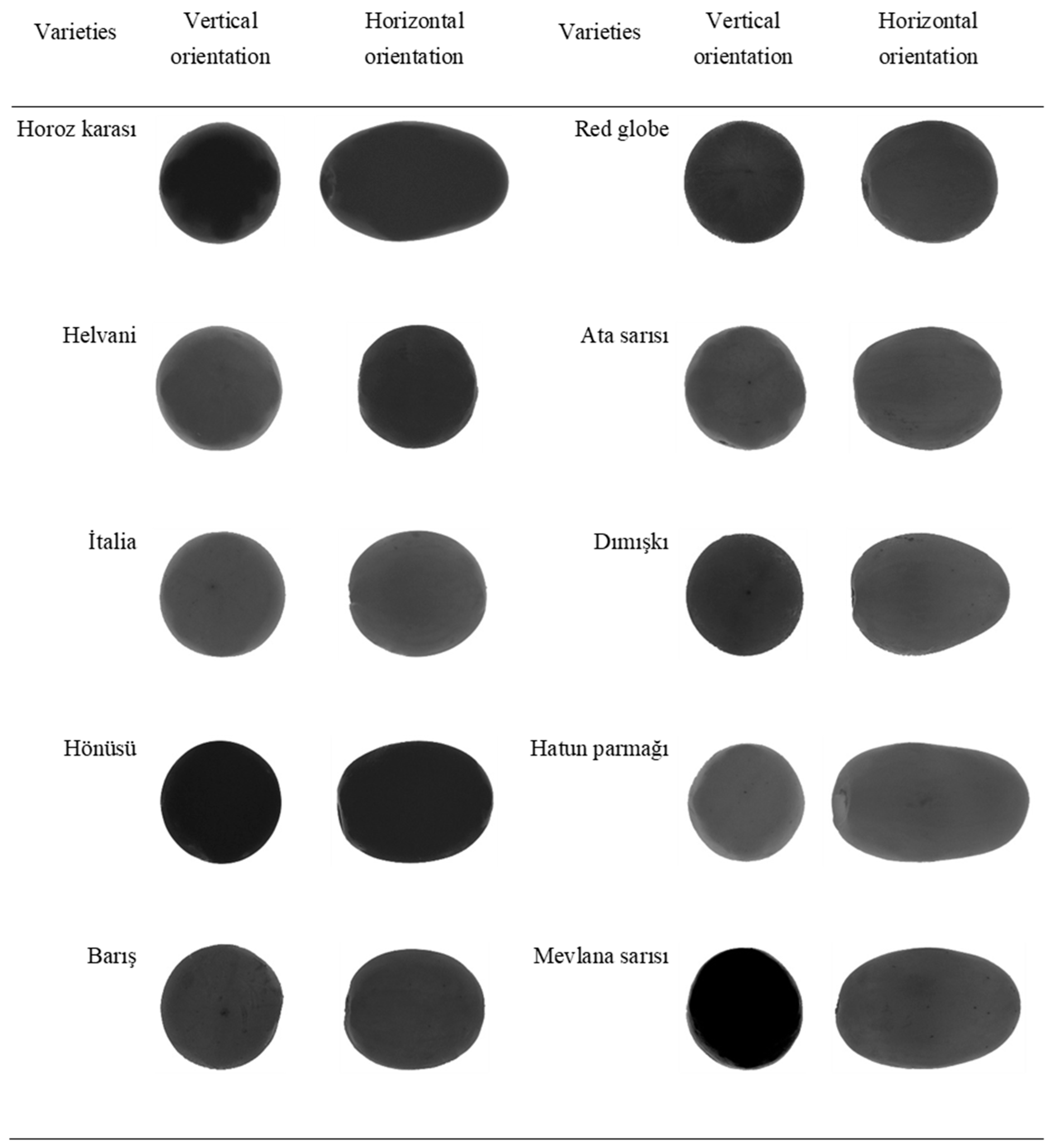
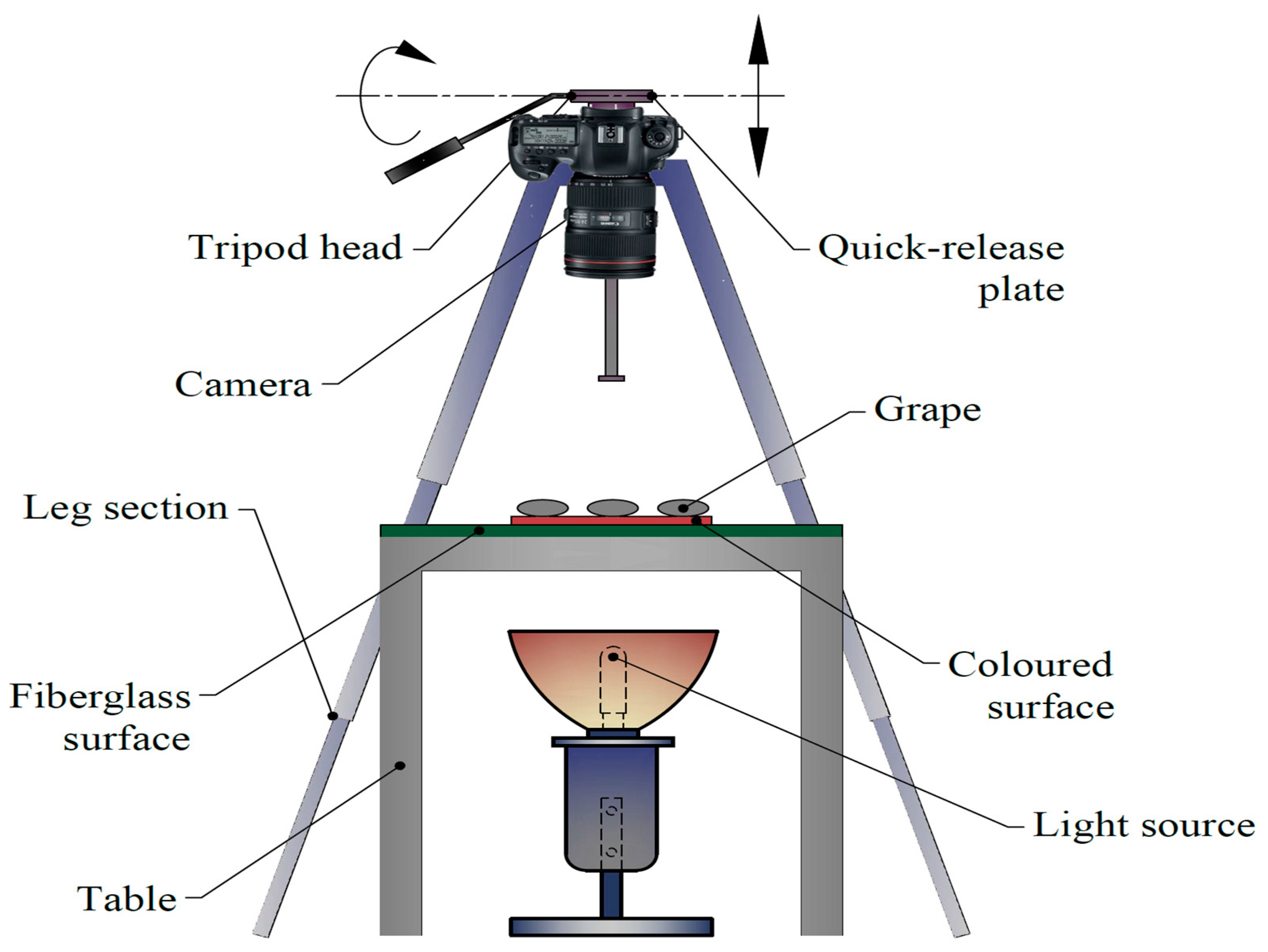
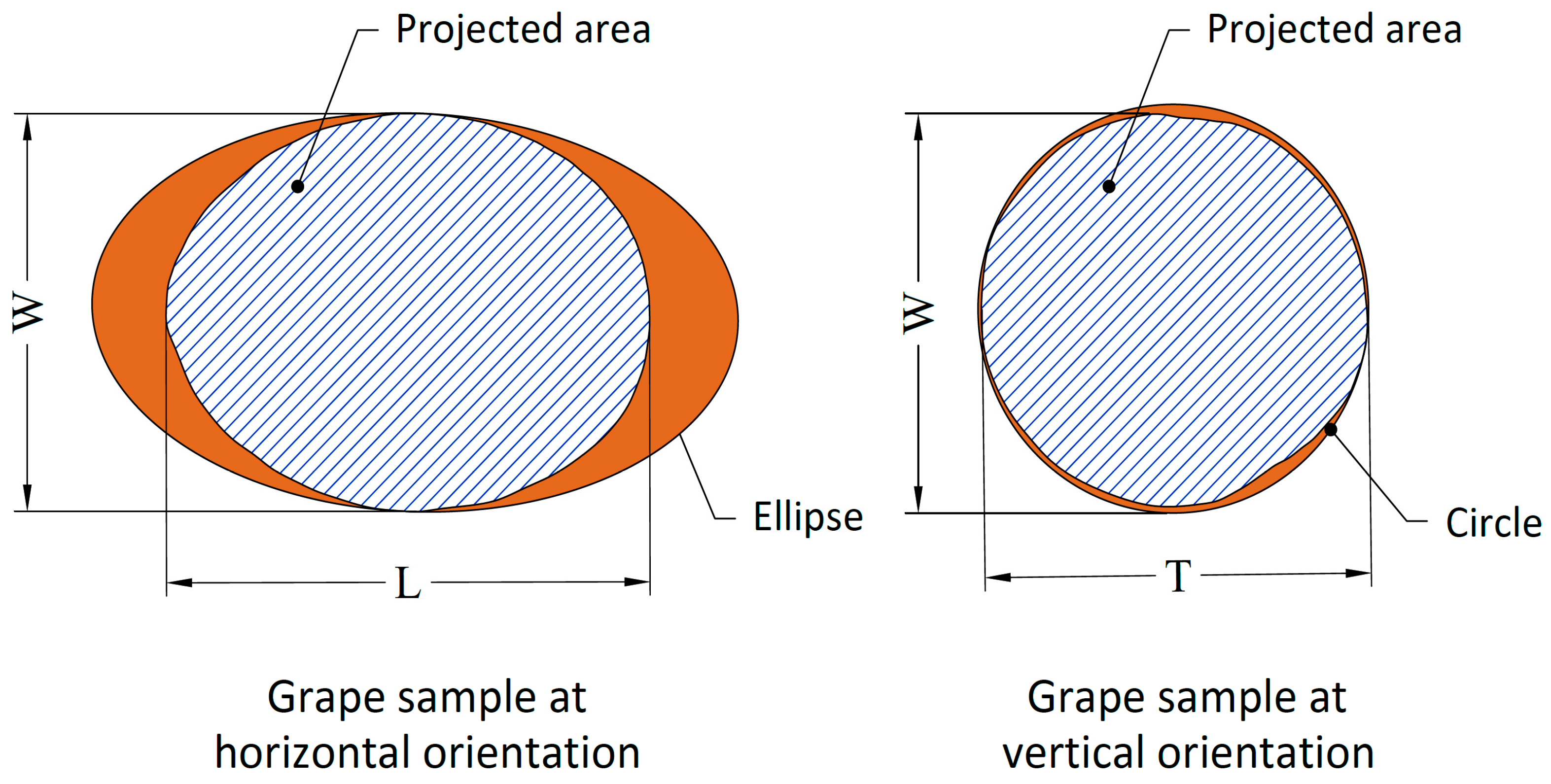
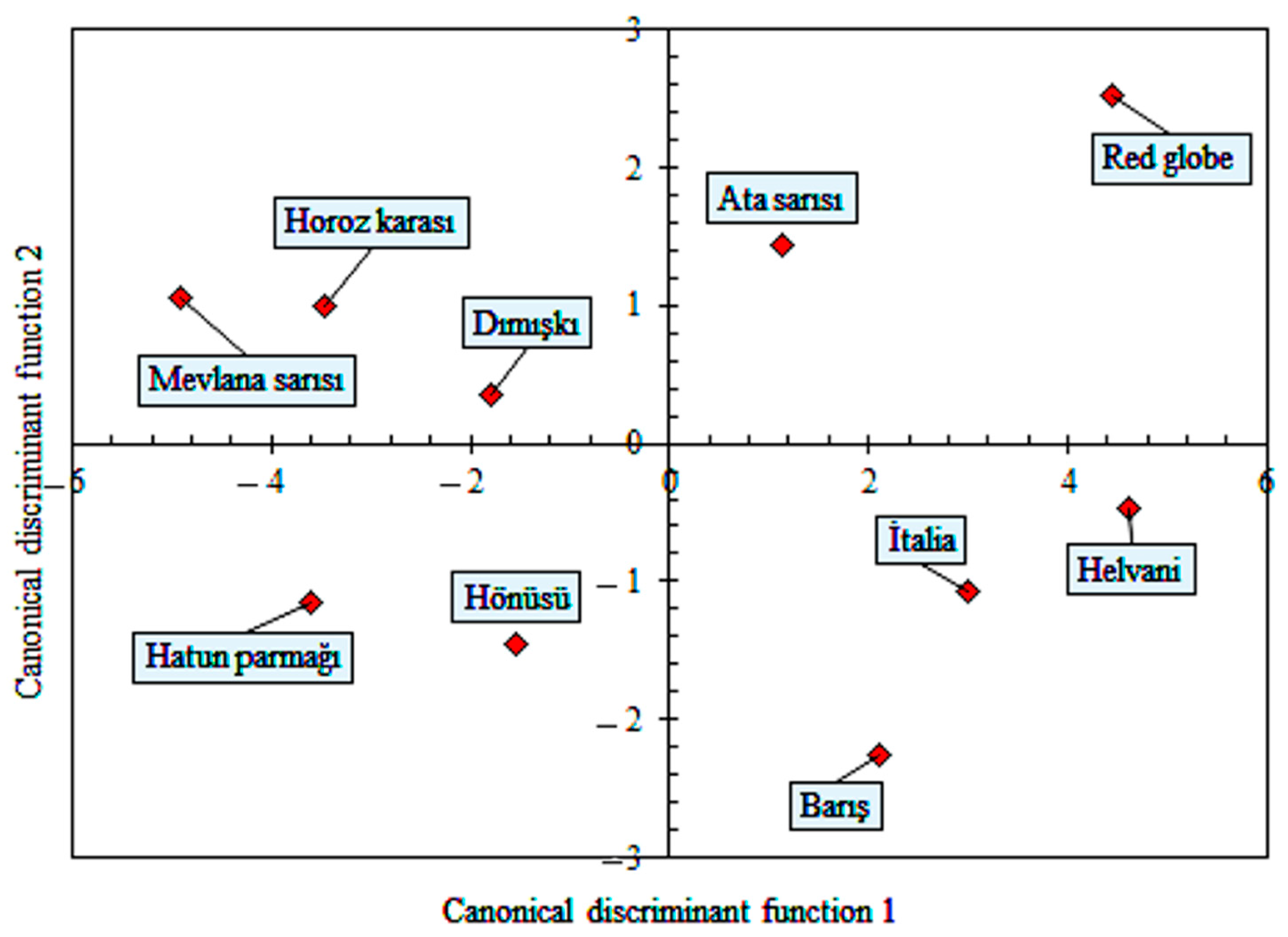

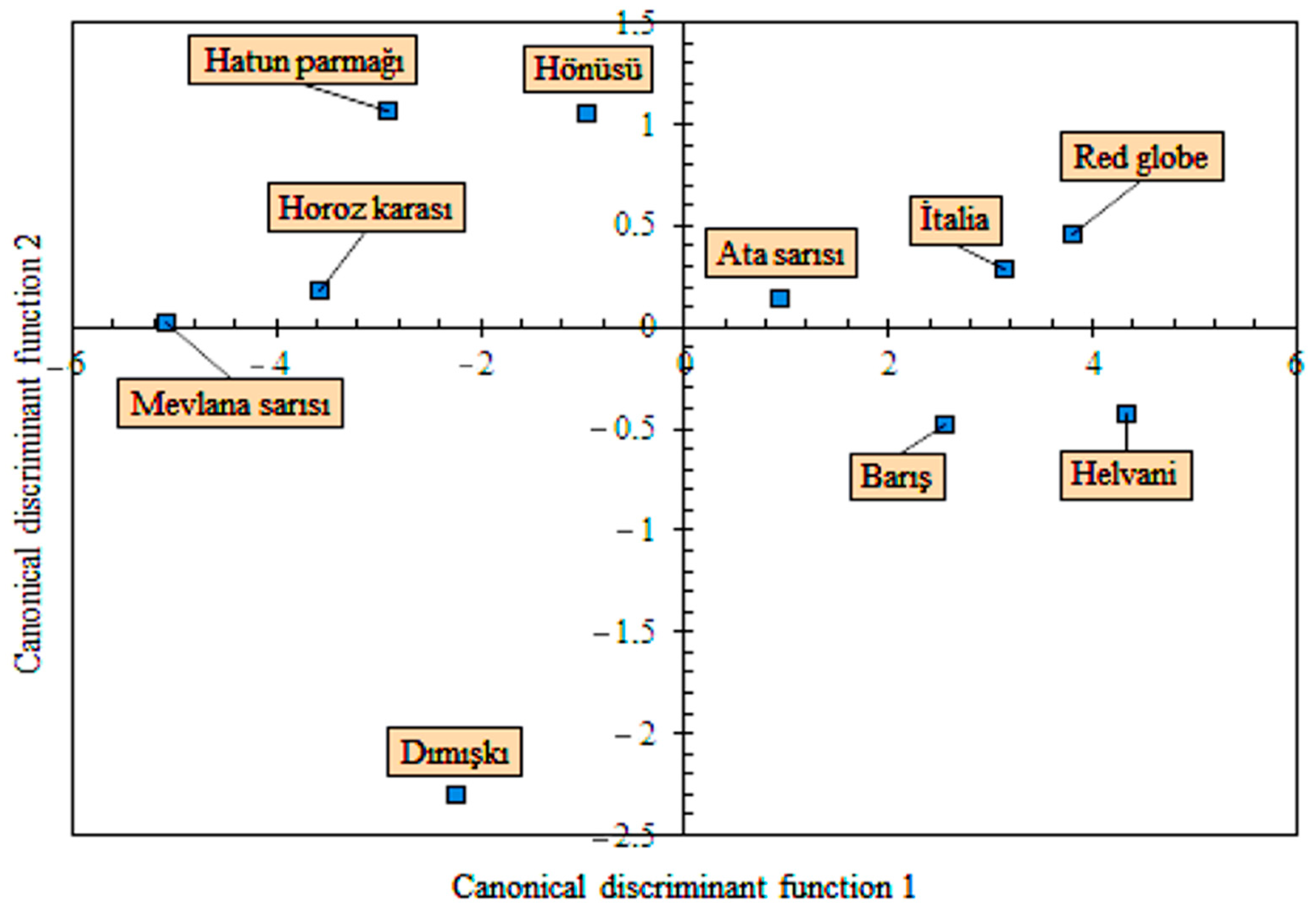
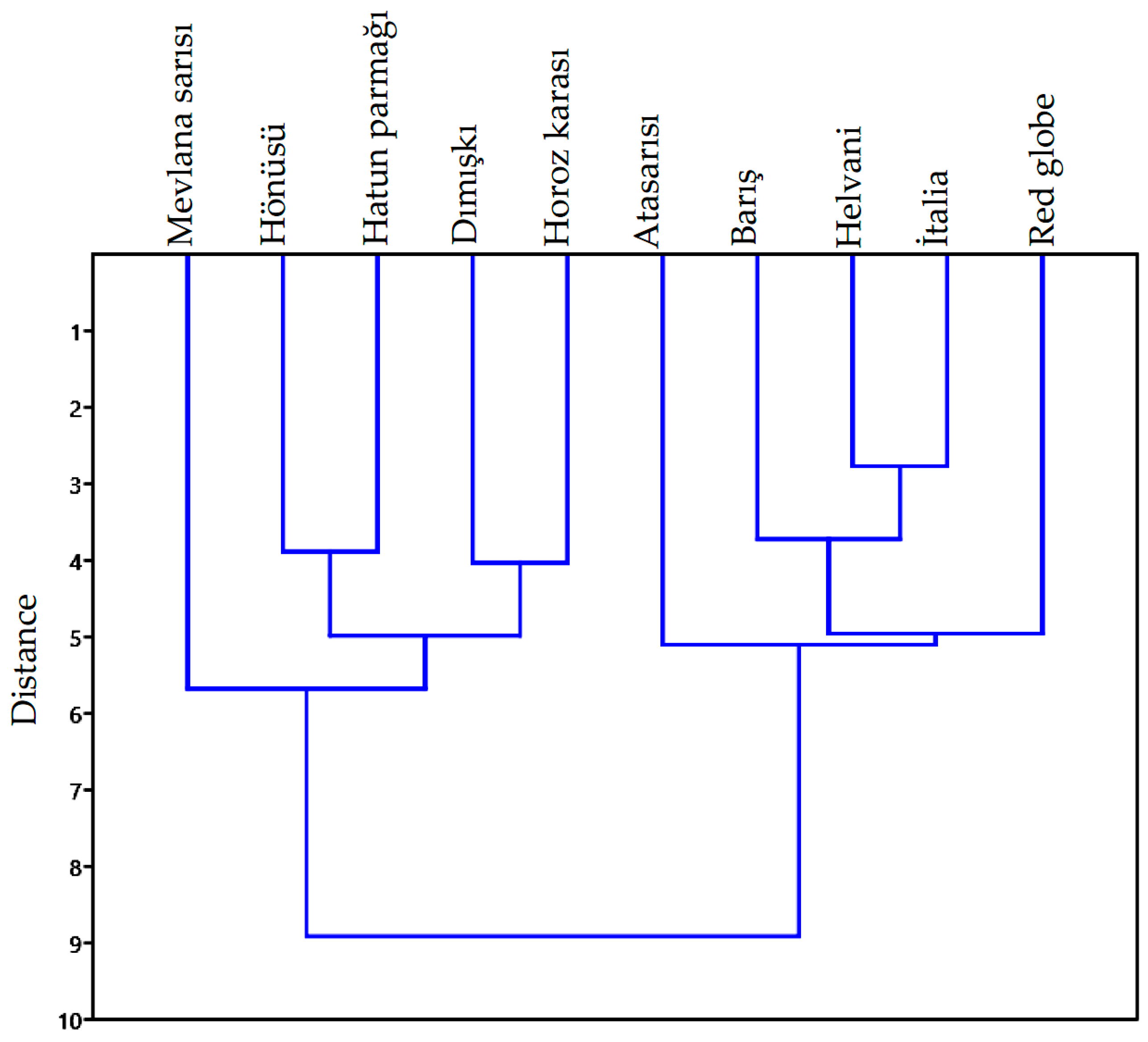
| Size and Shape Traits | Equations | References |
|---|---|---|
| Maximum elongation () | [15] | |
| Minimum elongation () | [15] | |
| Geometric mean diameter (Dg, mm) | [37] | |
| Sphericity (φ, %) | [38] | |
| Volume (V, mm3) | Ellipse volume | |
| Surface area (SA, mm2) | [16] | |
| Circularity (C) | [13] |
| Varieties | Horizontal Orientation | Vertical Orientation | ||||||
|---|---|---|---|---|---|---|---|---|
| Projected Area (mm2) | Equivalent Diameter (mm) | Perimeter (mm) | Circularity | Projected Area (mm2) | Equivalent Diameter (mm) | Perimeter (mm) | Circularity | |
| Ata Sarısı | 611.1 ± 56.0 a * | 27.87 ± 1.26 a | 95.33 ± 4.60 ab | 0.844 ± 0.019 b | 499.9 ± 46.3 b | 25.20 ± 1.16 b | 87.30 ± 4.51 b | 0.824 ± 0.050 d |
| Barış | 430.0 ± 55.0 e | 23.35 ± 1.49 e | 80.02 ± 6.04 e | 0.842 ± 0.032 b | 376.4 ± 44.7 de | 21.85 ± 1.29 de | 74.54 ± 4.58 d | 0.849 ± 0.029 bc |
| Dımışkı | 527.8 ± 36.4 c | 25.91 ± 0.89 c | 90.71 ± 3.52 c | 0.806 ± 0.026 c | 390.1 ± 27.3 d | 22.27 ± 0.77 d | 75.56 ± 2.90 d | 0.858 ± 0.019 b |
| Hatun Parmağı | 467.4 ± 40.0 d | 24.37 ± 1.03 d | 84.91 ± 4.07 d | 0.814 ± 0.020 c | 306.0 ± 25.3 g | 19.72 ± 0.81 f | 67.47 ± 3.04 f | 0.844 ± 0.031 bcd |
| Helvani | 492.7 ± 34.4 d | 25.03 ± 0.87 d | 84.47 ± 3.04 d | 0.867 ± 0.014 a | 474.9 ± 37.3 b | 24.57 ± 0.96 b | 82.01 ± 3.18 c | 0.886 ± 0.008 a |
| Horoz karası | 585.0 ± 48.4 ab | 27.27 ± 1.14 ab | 94.69 ± 3.95 ab | 0.819 ± 0.014 c | 390.3 ± 38.5 d | 22.27 ± 1.13 d | 75.64 ± 4.12 d | 0.856 ± 0.042 b |
| Hönüsü | 483.6 ± 35.6 d | 24.80 ± 0.91 d | 84.58 ± 3.36 d | 0.849 ± 0.013 b | 356.0 ± 21.9 ef | 21.28 ± 0.65 e | 71.06 ± 2.15 e | 0.885 ± 0.007 a |
| İtalia | 479.7 ± 51.0 d | 24.68 ± 1.30 d | 83.21 ± 4.29 d | 0.868 ± 0.016 a | 433.3 ± 45.8 c | 23.46 ± 1.22 c | 79.80 ± 3.70 c | 0.853 ± 0.032 b |
| Mevlana sarısı | 550.2 ± 55.7 bc | 26.44 ± 1.34 bc | 93.76 ± 5.16 bc | 0.785 ± 0.021 d | 329.8 ± 34.5 fg | 20.47 ± 1.06 f | 70.82 ± 4.50 e | 0.827 ± 0.049 cd |
| Red globe | 615.1 ± 68.6 a | 27.94 ± 1.53 a | 97.20 ± 5.57 a | 0.818 ± 0.050 c | 577.2 ± 73.1 a | 27.06 ± 1.69 a | 93.71 ± 7.05 a | 0.825 ± 0.039 cd |
| Mean ± SD | 524.3 ± 77.9 | 25.77 ± 1.91 | 88.89 ± 7.29 | 0.831 ± 0.036 | 413.4 ± 89.5 | 22.81 ± 2.42 | 77.79 ± 8.71 | 0.851 ± 0.040 |
| Min–max | 327.6–822.0 | 20.42–32.35 | 68.39–112.74 | 0.654–0.891 | 254.7–789.6 | 18.01–31.71 | 61.81–111.2 | 0.667–0.897 |
| Varieties | Length (mm) | Width (mm) | Thickness (mm) | Geometric Mean Diameter (mm) | Sphericity (%) | Max Elongation | Min Elongation | Surface Area (cm2) | Volume (cm3) |
|---|---|---|---|---|---|---|---|---|---|
| Ata Sarısı | 30.87 ± 1.78 b * | 25.21 ± 1.36 b | 25.60 ± 1.25 b | 27.10 ± 1.19 b | 87.9 ± 3.2 e | 1.227 ± 0.076 f | 1.046 ± 0.018 bc | 23.11 ± 2.06 b | 10.476 ± 1.413 b |
| Barış | 24.96 ± 1.81 e | 21.94 ± 1.38 e | 21.96 ± 1.36 f | 22.90 ± 1.40 g | 91.9 ± 2.7 d | 1.139 ± 0.056 g | 1.037 ± 0.021 cd | 16.54 ± 2.02 h | 6.360 ± 1.169 gh |
| Dımışkı | 30.83 ± 1.64 b | 21.98 ± 0.86 e | 22.70 ± 0.80 e | 24.86 ± 0.79 d | 80.8 ± 3.2 g | 1.405 ± 0.089 d | 1.038 ± 0.019 cd | 19.44 ± 1.24 de | 8.070 ± 0.779 de |
| Hatun parmağı | 29.28 ± 1.81 c | 19.66 ± 0.82 h | 19.98 ± 1.05 h | 22.56 ± 0.87 g | 77.2 ± 3.3 h | 1.491 ± 0.093 c | 1.049 ± 0.028 b | 16.01 ± 1.24 h | 6.035 ± 0.706 h |
| Helvani | 25.94 ± 1.04 d | 24.67 ± 0.99 c | 24.65 ± 1.06 c | 25.07 ± 0.92 d | 96.7 ± 1.9 a | 1.052 ± 0.030 i | 1.029 ± 0.016 de | 19.78 ± 1.47 d | 8.288 ± 0.926 d |
| Horoz karası | 33.77 ± 1.55 a | 22.00 ± 1.02 e | 22.70 ± 1.35 e | 25.64 ± 1.13 c | 76.0 ± 2.3 i | 1.536 ± 0.065 b | 1.041 ± 0.023 bc | 20.69 ± 1.80 c | 8.874 ± 1.142 c |
| Hönüsü | 28.61 ± 1.41 c | 21.19 ± 0.81 f | 21.41 ± 0.80 g | 23.49 ± 0.77 f | 82.2 ± 2.5 f | 1.351 ± 0.067 e | 1.045 ± 0.023 bc | 17.36 ± 1.13 g | 6.809 ± 0.666 g |
| İtalia | 26.11 ± 1.39 d | 23.45 ± 1.32 d | 23.58 ± 1.23 d | 24.34 ± 1.23 e | 93.3 ± 2.1 c | 1.114 ± 0.039 g | 1.026 ± 0.015 e | 18.66 ± 1.90 ef | 7.611 ± 1.176 ef |
| Mevlana sarısı | 33.77 ± 2.20 a | 20.17 ± 1.10 g | 20.92 ± 1.16 g | 24.23 ± 1.15 e | 71.9 ± 2.7 j | 1.676 ± 0.097 a | 1.063 ± 0.031 a | 18.48 ± 1.77 f | 7.495 ± 1.082 f |
| Red Globe | 29.29 ± 1.59 c | 27.08 ± 1.61 a | 27.22 ± 1.97 a | 27.83 ± 1.61 a | 95.1 ± 2.3 b | 1.083 ± 0.042 h | 1.042 ± 0.025 bc | 24.42 ± 2.88 a | 11.404 ± 2.06 a |
| Mean ± SD | 29.34 ± 3.35 | 22.73 ± 2.50 | 23.07 ± 2.45 | 24.80 ± 1.97 | 85.3 ± 8.8 | 1.307 ± 0.217 | 1.042 ± 0.024 | 19.45 ± 3.14 | 8.142 ± 2.009 |
| Min–max | 21.06–39.33 | 17.99–32.07 | 18.22–31.75 | 20.09–32.3 | 65.4–99.1 | 1.011–1.961 | 1.003–1.155 | 12.68–32.77 | 4.245–17.641 |
| Size and Shape Traits | Functions | ||||||||
|---|---|---|---|---|---|---|---|---|---|
| 1 | 2 | 3 | 4 | 5 | 6 | 7 | 8 | 9 | |
| Sphericity | 0.942 * | −0.207 | −0.049 | −0.070 | −0.039 | 0.053 | 0.044 | −0.152 | −0.041 |
| Max elongation | −0.878 * | 0.277 | 0.216 | 0.215 | 0.027 | −0.088 | 0.014 | 0.140 | 0.062 |
| Perimeter at horizontal | −0.077 | 0.881 * | −0.098 | −0.041 | −0.057 | 0.121 | −0.225 | 0.195 | 0.283 |
| Projected area at horizontal | −0.009 | 0.832 * | −0.18 | −0.027 | 0.070 | 0.317 | −0.363 | 0.107 | 0.133 |
| Length | −0.393 | 0.817 * | −0.132 | 0.155 | 0.042 | 0.174 | −0.246 | 0.146 | 0.141 |
| Perimeter at vertical | 0.420 | 0.799 * | −0.169 | −0.133 | −0.072 | 0.321 | −0.021 | 0.103 | −0.138 |
| Thickness | 0.394 | 0.726 * | −0.246 | −0.033 | 0.044 | 0.176 | −0.116 | −0.033 | 0.119 |
| Width | 0.481 | 0.704 * | −0.226 | −0.078 | 0.088 | 0.215 | −0.329 | −0.033 | 0.043 |
| Circularity at horizontal | 0.219 | −0.337 | −0.221 | 0.108 | 0.502 * | 0.488 | −0.226 | −0.258 | −0.398 |
| Circularity at vertical | 0.021 | −0.253 | −0.173 | 0.185 | 0.405 | −0.416 | −0.572 * | −0.001 | 0.396 |
| A. Canonical Discriminant Functions (Computed in SPSS ver. 20) | ||||||||||
| Functions | Eigenvalue | % of Variance | Cumulative, % | Canonical Correlation | ||||||
| 1 | 11.302 | 65.7 | 65.7 | 0.958 | ||||||
| 2 | 2.110 | 12.3 | 77.9 | 0.824 | ||||||
| 3 | 1.503 | 8.7 | 86.7 | 0.775 | ||||||
| 4 | 1.298 | 7.5 | 94.2 | 0.752 | ||||||
| 5 | 0.501 | 2.9 | 97.1 | 0.578 | ||||||
| 6 | 0.366 | 2.1 | 99.2 | 0.517 | ||||||
| 7 | 0.071 | 0.4 | 99.6 | 0.257 | ||||||
| 8 | 0.054 | 0.3 | 100.0 | 0.227 | ||||||
| 9 | 0.006 | 0.0 | 100.0 | 0.079 | ||||||
| B. MANOVA Results (computed in PAST ver. 4.05) | ||||||||||
| Statistics | Value | Hypothesis df | Error df | F Value | p (Sigma) | |||||
| Wilks’ lambda | 0.001952 | 90 | 2594 | 43.5 | 0.0000 ** | |||||
| Pillai trace | 3.488 | 90 | 3501 | 24.61 | 0.0000 ** | |||||
| C. Hotelling’s Pairwise Comparisons. (Bonferroni Corrected p Values in Upper Triangle; Mahalanobis Distances in Lower Triangle) (Computed in PAST ver. 4.05)* | ||||||||||
| Varieties | Horoz karası | Helvani | İtalia | Hönüsü | Barış | Red Globe | Ata Sarısı | Dımışkı | Hatun Parmağı | Mevlana sarısı |
| Horoz karası | 7.5E−39 ** | 1.0E−3 ** | 6.1E−20 ** | 4.0E−33 ** | 6.6E−40 ** | 7.8E−26 ** | 2.7E−11 ** | 5.8E−23 ** | 8.7E−19 ** | |
| Helvani | 72.5 | 2.6E−09 ** | 3.6E−33 ** | 2.1E−20 ** | 8.9E−21 ** | 4.5E−26 ** | 5.5E−34 ** | 2.6E−40 ** | 4.7E−43 ** | |
| İtalia | 50.2 | 6.2 | 1.2E−24 ** | 4.8E−11 ** | 2.7E−22 ** | 7.7E−18 ** | 1.1E−27 ** | 5.4E−34 ** | 8.5E−39 ** | |
| Hönüsü | 17.4 | 48.3 | 25.4 | 8.3E−24 ** | 1.6E−35 ** | 5.8E−21 ** | 2.3E−12 ** | 5.3E−15 ** | 2.9E−28 ** | |
| Barış | 48.1 | 18.1 | 7.6 | 23.8 | 4.7E−28 ** | 2.6E−22 ** | 2.7E−26 ** | 4.8E−31 ** | 8.3E−38 ** | |
| Red Globe | 78.2 | 18.6 | 21.1 | 57.3 | 33.0 | 1.8E−21 ** | 2.3E−34 ** | 4.0E−40 ** | 4.2E−43 ** | |
| Ata Sarısı | 27.9 | 28.4 | 14.5 | 18.9 | 21.1 | 19.7 | 4.1E−19 ** | 1.2E−29 ** | 1.6E−34 ** | |
| Dımışkı | 7.8 | 51.2 | 32.1 | 8.7 | 28.9 | 52.7 | 16.2 | 9.6E−21 ** | 3.5E−26 ** | |
| Hatun Parmağı | 22.3 | 80.4 | 51.2 | 11.2 | 41.3 | 79.4 | 37.3 | 18.6 | 2.5E−19 ** | |
| Mevlana sarısı | 15.8 | 97.4 | 72.3 | 33.6 | 67.4 | 97.8 | 53.3 | 28.6 | 16.5 | |
| D. % Classification Performance (80.8% of Original Grouped Cases Were Correctly Classified) (Computed in SPSS ver. 20.0) | ||||||||||
| Varieties | Horoz karası | Helvani | İtalia | Hönüsü | Barış | Red Globe | Ata Sarısı | Dımışkı | Hatun Parmağı | Mevlana sarısı |
| Horoz karası | 87.5 | 2.5 | 5 | 5 | ||||||
| Helvani | 87.5 | 10 | 2.5 | |||||||
| İtalia | 10 | 70 | 15 | 2.5 | 2.5 | |||||
| Hönüsü | 90 | 2.5 | 2.5 | 5 | ||||||
| Barış | 5 | 15 | 5 | 70 | 2.5 | 2.5 | ||||
| Red Globe | 7.5 | 2.5 | 85 | 5 | ||||||
| Ata Sarısı | 2.5 | 5 | 5 | 87.5 | ||||||
| Dımışkı | 12.5 | 2.5 | 10 | 2.5 | 72.5 | |||||
| Hatun Parmağı | 2.5 | 5 | 87.5 | 5 | ||||||
| Mevlana sarısı | 12.5 | 17.5 | 70 | |||||||
| A. Canonical Discriminant Functions (Computed in SPSS ver. 20) | ||||||||||
| Functions | Eigenvalue | % of variance | Cumulative % | Canonical correlation | ||||||
| 1 | 10.612 | 92.6 | 92.6 | 0.956 | ||||||
| 2 | 0.853 | 7.4 | 100.0 | 0.679 | ||||||
| B. MANOVA Results (Computed in PAST ver. 4.05) | ||||||||||
| Statistics | Value | Hypothesis df | Error df | F value | p (Sigma) | |||||
| Wilks’ lambda | 0.04647 | 18 | 778 | 157.3 | 0.0000 | |||||
| Pillai trace | 1.374 | 18 | 780 | 95.17 | 0.0000 | |||||
| C. Hotelling’s Pairwise Comparisons. (Bonferroni corrected p values in upper triangle; Mahalanobis distances in lower triangle) (computed in PAST ver. 4.05) * | ||||||||||
| Varieties | Horoz karası | Helvani | İtalia | Hönüsü | Barış | Red Globe | Ata Sarısı | Dımışkı | Hatun Parmağı | Mevlana sarısı |
| Horoz karası | 1.73E−46 | 2.35E−41 | 3.66E−17 | 1.08E−38 | 2.60E−44 | 1.23E−29 | 1.19E−17 | 1.72E−03 | 6.56E−07 | |
| Helvani | 62.57 | 1.06E−05 | 3.30E−35 | 5.60E−09 | 4.99E−03 | 2.91E−22 | 6.29E−42 | 2.33E−44 | 5.07E−52 | |
| İtalia | 45.00 | 1.90 | 2.14E−27 | 1.05E−02 | 5.42E−01 * | 1.47E−12 | 7.28E−38 | 1.66E−38 | 9.75E−48 | |
| Hönüsü | 7.61 | 29.96 | 17.32 | 4.40E−25 | 2.35E−31 | 9.74E−12 | 1.37E−23 | 1.24E−10 | 4.70E−28 | |
| Barış | 37.80 | 3.15 | 0.95 | 14.58 | 2.68E−07 | 1.68E−08 | 2.61E−33 | 2.64E−36 | 2.01E−45 | |
| Red Globe | 54.46 | 1.04 | 0.47 * | 22.99 | 2.48 | 3.99E−18 | 3.97E−41 | 1.43E−41 | 3.10E−50 | |
| Ata Sarısı | 20.36 | 11.71 | 4.84 | 4.42 | 2.95 | 8.29 | 1.61E−26 | 3.87E−26 | 4.09E−38 | |
| Dımışkı | 7.95 | 46.70 | 35.79 | 13.00 | 26.32 | 44.34 | 16.23 | 2.46E−22 | 4.91E−24 | |
| Hatun Parmağı | 1.18 | 54.62 | 37.34 | 3.89 | 32.25 | 45.63 | 15.78 | 11.78 | 3.07E−14 | |
| Mevlana sarısı | 2.33 | 88.64 | 67.73 | 18.17 | 58.47 | 79.27 | 36.38 | 13.46 | 5.76 | |
| D. Classification performance (56.0% of original grouped cases were correctly classified) (computed in SPSS ver. 20.0) | ||||||||||
| Varieties | Horoz karası | Helvani | İtalia | Hönüsü | Barış | Red Globe | Ata Sarısı | Dımışkı | Hatun Parmağı | Mevlana sarısı |
| Horoz karası | 37.5 | 0 | 0 | 5.0 | 0 | 0 | 0 | 2.5 | 35.0 | 20.0 |
| Helvani | 0 | 70.0 | 7.5 | 0 | 2.5 | 20.0 | 0 | 0 | 0 | 0 |
| İtalia | 0 | 15.0 | 32.5 | 0 | 17.5 | 22.5 | 12.5 | 0 | 0 | 0 |
| Hönüsü | 0 | 0 | 0 | 67.5 | 0 | 0 | 10.0 | 7.5 | 15.0 | 0 |
| Barış | 0 | 15 | 22.5 | 0 | 40.0 | 2.5 | 20.0 | 0 | 0 | 0 |
| Red Globe | 0 | 27.5 | 25.0 | 0 | 7.5 | 40.0 | 0 | 0 | 0 | 0 |
| Ata Sarısı | 0 | 5.0 | 2.5 | 22.5 | 17.5 | 0 | 52.5 | 0 | 0 | 0 |
| Dımışkı | 10.0 | 0 | 0 | 0 | 0 | 0 | 2.5 | 87.5 | 0 | 0 |
| Hatun Parmağı | 25.0 | 0 | 0 | 22.5 | 0 | 0 | 0 | 0 | 45.0 | 7.5 |
| Mevlana sarısı | 12.5 | 0 | 0 | 0 | 0 | 0 | 0 | 0 | 0 | 87.5 |
Publisher’s Note: MDPI stays neutral with regard to jurisdictional claims in published maps and institutional affiliations. |
© 2021 by the authors. Licensee MDPI, Basel, Switzerland. This article is an open access article distributed under the terms and conditions of the Creative Commons Attribution (CC BY) license (https://creativecommons.org/licenses/by/4.0/).
Share and Cite
Kupe, M.; Sayinci, B.; Demir, B.; Ercisli, S.; Aslan, K.A.; Gundesli, M.A.; Baron, M.; Sochor, J. Multivariate Analysis Approaches for Dimension and Shape Discrimination of Vitis vinifera Varieties. Plants 2021, 10, 1528. https://doi.org/10.3390/plants10081528
Kupe M, Sayinci B, Demir B, Ercisli S, Aslan KA, Gundesli MA, Baron M, Sochor J. Multivariate Analysis Approaches for Dimension and Shape Discrimination of Vitis vinifera Varieties. Plants. 2021; 10(8):1528. https://doi.org/10.3390/plants10081528
Chicago/Turabian StyleKupe, Muhammed, Bahadır Sayinci, Bünyamin Demir, Sezai Ercisli, Kürşat Alp Aslan, Muhammet Ali Gundesli, Mojmir Baron, and Jiri Sochor. 2021. "Multivariate Analysis Approaches for Dimension and Shape Discrimination of Vitis vinifera Varieties" Plants 10, no. 8: 1528. https://doi.org/10.3390/plants10081528
APA StyleKupe, M., Sayinci, B., Demir, B., Ercisli, S., Aslan, K. A., Gundesli, M. A., Baron, M., & Sochor, J. (2021). Multivariate Analysis Approaches for Dimension and Shape Discrimination of Vitis vinifera Varieties. Plants, 10(8), 1528. https://doi.org/10.3390/plants10081528








